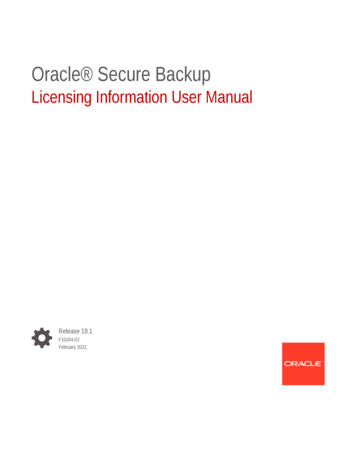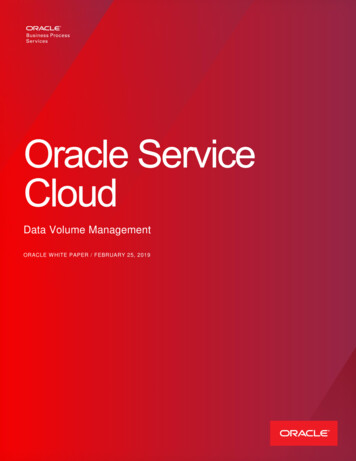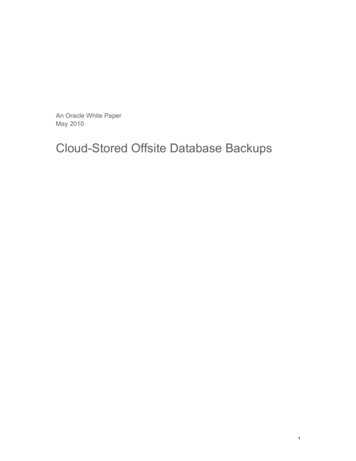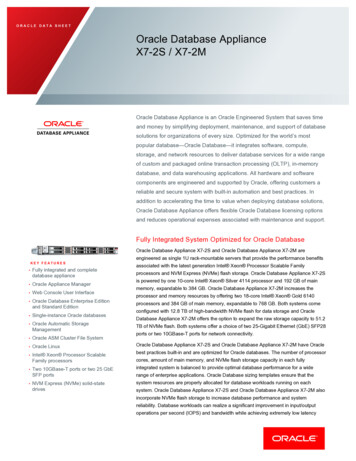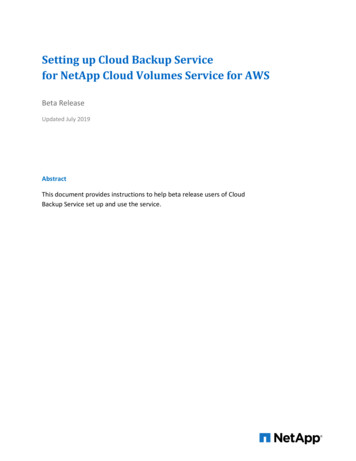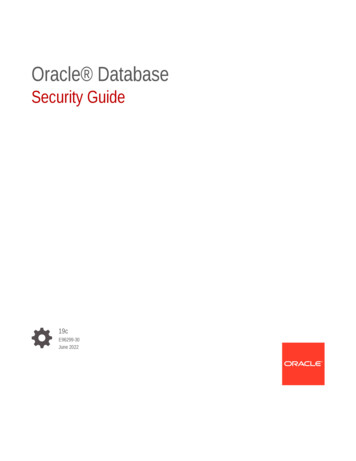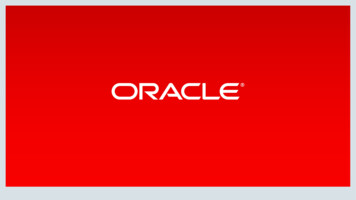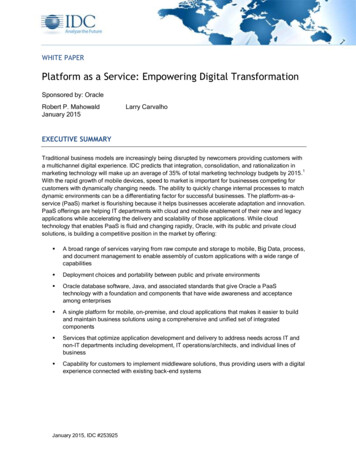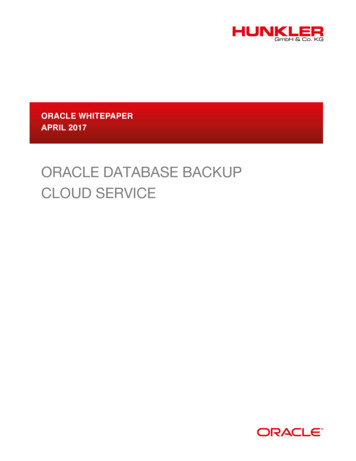
Transcription
ORACLE WHITEPAPERAPRIL 2017ORACLE DATABASE BACKUPCLOUD SERVICE
Oracle Database Backup Cloud ServiceBest Practices for On-Premise and Cloud DatabasesORACLE WHITE PAPER APRIL 2017
Table of ContentsIntroduction1Why Backup to the Cloud?2Traditional Database Backup Best PracticesOracle Database Backup Cloud Service: Overview23Cloud Backup Module5Architecture of Oracle Cloud Backup when used with On-Premise Databases7Architecture of Oracle Cloud Backup when used with Cloud Deployed Databases7Oracle Database Backup Cloud Service: Best PracticesBackup88Recovery10Additional Best Practices:13ConclusionORACLE DATABASE BACKUP CLOUD SERVICE - BEST PRACTICES FOR ON-PREMISE AND CLOUD DATABASES14
IntroductionOracle Database Backup Cloud Service is a secure, scalable, on-demand storage solution for backingup Oracle On-premise or cloud databases to the public cloud. Oracle Database Backup Cloud Servicecomplements your existing backup strategy by providing an off-site storage location in the cloud.Storage management and data transfer complexities are handled by the service, not by databaseadministrators. Database Administrators use the familiar RMAN (Oracle Recovery Manager) interfaceto perform backup and restore operations, so there’s no need to learn new tools or commands.If you know how to back up to tape or disk, then you know how to back up to the cloud. OracleDatabase Backup Cloud Service is easy to get and use. Your data is always available and alwayssecure, and you can quickly scale up the storage capacity when needed.1 ORACLE DATABASE BACKUP CLOUD SERVICE - BEST PRACTICES FOR ON-PREMISE AND CLOUD DATABASES
Why Backup to the Cloud?Storing database backups off-site is critical for organizations to be disaster ready. To reduce application downtime,backups must be accessible 24 x 7.Why business-critical backups must be kept off-site? It’s best practice to a have a disaster recovery and dataprotection plan when your source database or system is irreparable. Off-site backup is typically accomplished bysending backups to tape and shipping the tapes to a secure location. This is a complex procedure endeavor as itrequires: Hardware, personnel, and procedures to make sure off-site backups are current, protected, and availableat a moment’s notice should the unthinkable happen. Many small and medium businesses don’t have a tapeinfrastructure, and end up deploying some form of virtual tape or disks for storing backups and archives.Oracle Cloud storage provides a great alternative to writing, shipping, and storing tapes at an off-site location whichincreases performance, redundancy, and security.Traditional Database Backup Best PracticesThe following table summarizes the traditional Database Backup Best Practices.Challenges with Traditional Backup InfrastructureTraditional backup strategies are facing increasing challenges which affects directly the Backup and Recovery bestpractices. Some of these challenges are:On-Demand Capacity Growth:With explosive data growth, storage capacity planning for the long term retention is a challenge.No DR/Tape InfrastructureNot everyone has tape infrastructure or secure and reliable remote (DR) site for taking backups and to store offsiteAccessibility IssuesWith Tape-vaulting, offsite data is not immediately accessible which increases RTOHigh CostIncreasing capital expenditures to procure and manage onsite & offsite backup infrastructure and operations.*-These procedures will change when the Recovery Appliance is the backup destination.
Oracle Database Backup Cloud Service: OverviewDisaster strikes without warning. With Oracle Database Backup Cloud Service, your backups are alwaysaccessible and secure over the Internet and are immediately available for recovery when needed. Data isautomatically and transparently replicated across multiple storage nodes in the same geographic region, whichprotects against hardware failure and data corruption.Oracle Database Backup Cloud Service protects your data by providing end-to end security. Your data isencrypted at the source, securely transmitted to the cloud, and securely stored in the cloud. You keep the keys atyour site, not in the cloud.Oracle Database Backup Cloud Service is simple to deploy and easy to use. Subscribe to the service, installthe cloud backup module, configure a few settings, and you’re ready to back up to the cloud using familiarcommands and tools. It’s that simpleCertification Matrix and SupportabilityOracle Database Backup Cloud Service supports the Certification Matrix below.Database / FeaturesSupported Versions / OptionsOracle Database – Enterprise Edition*10.2.0.5, 11.1,11.2, 12c (64 bits)Oracle Database – SE/SE1/SE2*10.2.0.5, 11.1.0.7, 11.2.0.3, and versions 11.2.0.4 andabovePlatforms (64 bits)Linux, Solaris, SPARC, Windows, HP-UX, AIX, zLinuxRMAN Compression (Included)HIGH, MEDIUM, BASIC, LOW (depends on DBversion)RMAN Encryption (Included)Password, TDE, Dual-mode* Older Database versions no longer supported by Oracle are in deprecated modeOracle Database Backup Cloud Service supports the following RMAN operations :Database (Backupset)Backups FromFast Recovery AreaRestore from CloudMaintenanceBACKUPSET BackupsImage CopiesFull DatabaseRetention PeriodFull DatabaseArchived essedDatafileObsoleteEncrypted backup setsTable Recovery (12c)Delete ObsoleteBlock RecoveryDelete BackupsSelected Data FilesIncremental –DifferentialIncremental –CumulativeCompressedEncrypted*-These procedures will change when the Recovery Appliance is the backup destination.
RMAN Compression and Encryption:RMAN Compression (Optional)–10g: BASIC–11g and above: HIGH, BASIC, MEDIUM,LOW–MEDIUM recommended–No ACO licensing requiredCONFIGURE COMPRESSION ALGORITHM ‘MEDIUM’;BACKUP AS COMPRESSED BACKUPSET DATABASEPLUS ARCHIVELOG;RMAN Encryption (Mandatory)–Password, Transparent Data Encryption (TDE),Dual-Mode–No ASO licensing required–Keys are kept local (not in the storage cloud)–If TDE is used (preferred), then simply use SETENCRYPTION ON before backups and restores–For password encryption:SET ENCRYPTION ON IDENTIFIED BY ‘ password ’ONLY;–Before doing restore,SET DECRYPTION IDENTIFIED BY ‘ password ’;Setting up Oracle Database Backup Cloud Service in simple 4 steps.1. Subscribe for the Oracle Database Backup Cloud Service. You can do that from shop.oracle.com (or) work withyour Oracle representative. Alternatively, you can choose to give it a try using Database Cloud Service trial. Formore information, refer to cloud.oracle.com/database backup.2. Download and install the Oracle Database Cloud Backup Module from Oracle Technology Network (OTN). Themodule is what makes it possible to perform secure cloud backups and restores. You’ll install the module on thesystem where your Oracle database is running. Multiple database versions and operating systems are supported.3. After you install the backup module, you’ll configure a few RMAN settings.4.Then you’re ready to perform backup & recovery operations to the cloud using familiar RMAN commands.You’ll use the online dashboard to monitor your service and see how much storage capacity you’re using for yourbackups.*-These procedures will change when the Recovery Appliance is the backup destination.
High Level Architecture of Oracle Cloud BackupCloud Backup ModuleThe module is a system backup to tape (SBT) interface that’s tightly integrated with Recovery Manager (RMAN),which means you don't need to learn new tools or commands.You can continue to use standard RMAN commands for all backup, restore, recovery, and maintenance operationsYou’ll download the backup module from Oracle Technology Network (OTN) and install it on your database server.Multiple database versions and operating systems are supported. For more information about the module, seeInstalling the Oracle Database Cloud Backup Module.Workflow:1.RMAN streams backup data to the cloud via RMAN cloud module2.Cloud module breaks backup pieces into 100MB chunks (Default) and ships to the clouda.Failed transmissions are retried automatically.b.Multiple buffers (RMAN Channels) can be used for parallelism and to increase backupthroughput if there is sufficient network bandwidth.3.Each chunk is stored as an object inside the Oracle clouduser container. The container can either be userpre-created (or) automatically created by the RMAN cloud module.Default container name : “oracle-data[first 8 chars of service & domain]4.Uses REST API calls – PUT,GET, POST, HEAD & DELETE over HTTPS5.Typical URL formation for every objecta.http:// identitydomain .storage.oraclecloud.com/v1/ service - domain / container / piecename / unique ID /0000001, 0000002 .b.Creates and maintains metadata XML files in the cloud which acts as manifest files and used bythe RMAN module.*-These procedures will change when the Recovery Appliance is the backup destination.
Required Configuration Files for Cloud BackupsFile namelibopc.so(or) oraopc.dllopc SID .oraLocation / CreationPurposeUser specified library location.SBT library which enables backup toDownloaded by the installer.Oracle CloudConfigured by the installer underContains ODBS container URL ORACLE HOME/dbslocation for the user and also theODBS credential wallet locationcwallet.ssoUser specified wallet location duringOracle wallet which securely storesthe RMAN module installation.backup service credentials. This isused during RMAN backups andrestore operations .Wallet for encryption(optional –only needed for TDE)Either ORACLE BASEUsed for backup encryption. Existing/admin/ ORCLE SID /wallet (or)Oracle wallet can be used (or) newdefined in sqlnet.ora / Existing walletOracle wallet can be created.Content of the OPC Configuration File - Run time configurations (located under ORACLE HOME/opc sid .ora)Parameter NameDescriptionOPC HOSTREST destination yservicemydomainOPC WALLETOPC credential wallet locationEx: ‘LOCATION file:/home/oracle/OPC/walletCREDENTIAL ALIAS odbs opc’OPC CONTAINERUser specified container nameEx:PAYROLL DB(Customer need to create that using tools like cloudberryuntil Oracle Cloud has GUI)OPC CHUNK SIZESpecified in bytes. By default, 100MB. Not recommendedto change.OPC TRACE LEVELFor debug purposes only. Set this parameter to – say 100which generates more trace information in sbtio.log.*-These procedures will change when the Recovery Appliance is the backup destination.
Architecture of Oracle Cloud Backup when used with On-Premise DatabasesArchitecture of Oracle Cloud Backup when used with Cloud Deployed Databases*-These procedures will change when the Recovery Appliance is the backup destination.
Oracle Database Backup Cloud Service: Best PracticesIn this section we will discuss the best practices when backing-up or recovering to or from the Oracle CloudBackup Service. These best practices are based on native RMAN commands.Before you start, ensure you have installed the Oracle Cloud Backup module from OTN and you configure yourRMAN environment properly.RMAN CONFIGURE CHANNEL DEVICE TYPE 'SBT TAPE' PARMS'SBT LIBRARY /home/oracle/OPC/lib/libopc.so,ENV (OPC PFILE /u01/products/db/12.1/dbs/opcodbs.ora)';Backup RMAN encryption for backups is enforced (mandatory for On-Premise Databases)—Use the RMAN set encryption clause in your RMAN run block.RMAN SET ENCRYPTION ON IDENTIFIED BY 'abc123' ONLY;Keys are managed by the customer (password, TDE, dual-mode)Data securely transmitted to the cloud over HTTPS To optimize data transfer when network bandwidth is limited and CPU resources are available—Use RMAN compression (HIGH, MEDIUM, LOW, BASIC)RMAN CONFIGURE COMPRESSION ALGORITHM 'MEDIUM';RMAN BACKUP DEVICE TYPE SBT AS COMPRESSED BACKUPSET DATABASE PLUS ARCHIVELOGFORMAT '%d %U';—Increase PARALLELISM (until you reach acceptable network throughput or hit max throughputcapable with the existing network)RMAN CONFIGURE DEVICE TYPE 'SBT TAPE' PARALLELISM 4 BACKUP TYPE TO BACKUPSET;To determine network throughput for a specific time period, use RMAN network analyzer, seeMOS note 2022086.1To diagnose Oracle Cloud Backup Performance, see MOS note 2078576.1. Use MULTISECTION backupsThe purpose of multisection backups (available starting Oracle 11g) is to enable RMAN channels to backup a single large file in parallel. RMAN divides the work among multiple channels, with each channelbacking up one file section in a file. Backing up a file in separate sections can improve the performanceof backups of large data files. For example, suppose that the users tablespace contains a single datafileof 800 MB and assume that four SBT channels are configured, with the parallelism setting for the SBTdevice set to 4. You can break up the datafile in this tablespace into file sections as shown below.RMAN BACKUP SECTION SIZE 200M TABLESPACE USERS;*-These procedures will change when the Recovery Appliance is the backup destination.
Use “weekly full and daily incremental” strategyThe goal of an incremental backup is to back up only those data blocks that have changed sincea previous backup. This has a lot of benefits but prior to moving toward this standard approach, youshould evaluate if your RTO requirements can still be met.The advantages of this strategy are: Reduce the amount of time needed for daily backups. Since backup times are shorter, youhave an option to backup more frequently as well to reduce RPO.Reduce network usage and network bandwidth requirements when backing up over a network.Reduce backup overhead and read I/Os.The trade off is that restore and recovery time is longer since you have to restore the previous cumulativebackup and subsequent incremental plus redo to recover the database.Below is an example of a Weekly full/daily incremental strategy. SundayAn incremental level 0 backup backs up all blocks that have ever been in use in this database.RMAN BACKUP INCREMENTAL LEVEL 0 DATABASE PLUS ARCHIVELOG NOT BACKED UP DELETEINPUT; Monday - SaturdayOn each day from Monday through Saturday, a differential incremental level 1 backup backs up allblocks that have changed since the most recent incremental backup at level 1 or 0. So, the Mondaybackup copies blocks changed since Sunday level 0 backup, the Tuesday backup copies blockschanged since the Monday level 1 backup, and so forth.RMAN BACKUP INCREMENTAL LEVEL 1 DATABASE PLUS ARCHIVELOG NOT BACKED UP DELETEINPUT;RMAN's change tracking feature for incremental backups improves incremental backup performance byrecording changed blocks in each datafile in a change tracking file. If change tracking is enabled, RMANuses the change tracking file to identify changed blocks for incremental backup, thus avoiding the need toscan every block in the datafile.To enable or disable block change tracking refer to the example below. Additional information can alsobe found hereSQL ALTER DATABASE ENABLE BLOCK CHANGE TRACKING;SQL ALTER DATABASE DISABLE BLOCK CHANGE TRACKING;In summary, your RMAN configuration should contain similar settings to the below:CONFIGURE CHANNEL DEVICE TYPE 'SBT TAPE' PARMS'SBT LIBRARY /home/oracle/OPC/lib/libopc.so,ENV (OPC PFILE /u01/products/db/12.1/dbs/opcodbs.ora)'CONFIGURE COMPRESSION ALGORITHM 'MEDIUM’CONFIGURE CONTROLFILE AUTOBACKUP ONCONFIGURE DEVICE TYPE 'SBT TAPE' PARALLELISM 4 BACKUP TYPE TO BACKUPSETCONFIGURE BACKUP OPTIMIZATION ON*-These procedures will change when the Recovery Appliance is the backup destination.
You can always list your backups by using the RMAN list command, note the Media attribute name thatrefers to your storage domain the Oracle Cloud Service.RMAN LIST BACKUP;.BS Key Type LV SizeDevice Type Elapsed Time Completion Time------- ---- -- ---------- ----------- ------------ --------------48Full42.75MSBT TAPE00:01:3513-SEP-15BP Key: 48Status: AVAILABLE Compressed: YES Tag: TAG20150913T104509Handle: 2iqh1tpm 1 ce-usoracleiList of Datafiles in backup set 48File LV Type Ckp SCNCkp Time Name---- -- ---- ---------- --------- ---2Full 78506413-SEP-15 yBecause accidents can happen and often without warning, you need to ensure that your backups areavailable when you need them. Oracle Cloud Backup offers you performance, redundancy, and security,which in turn provide peace of mind. Nevertheless, testing your restore procedures and your backups isstill an important activity and should be performed regularly.Some of the important reasons that require recovery from your backups are below:1. Storage Failure2. Block Corruption3. User/Logical Error4. Database Failure5. Site failure or disasterPro-actively testing your backups is the key of successful recovery. Below are some important items toconsider.Follow generic Database MAA best practices to detect, prevent and repair from data corruptions.Preventing, Detecting, and Repairing Block Corruption - Oracle Database 12cPreventing, Detecting, and Repairing Block Corruption: Oracle Database 11gCrosscheck your backupsCrosschecking your backups is important and it should be done before a delete obsolete. If a backupset, or piece, has gone missing we want to delete it. Crosschecking only marks the missing backupset/piece as expired and does not delete or remove anything. Backup set/pieces marked as expired willnot count toward the retention policy of the delete obsolete command.Following any crosscheck command, it's a good idea to do a corresponding report expired. The deleteexpired will remove the entries flagged as expired from the RMAN repository.Use RMAN Crosscheck to check that files are accessible and ready for a restore operation.RMAN CROSSCHECK BACKUP;RMAN CROSSCHECK BACKUP OF DATABASE;RMAN LIST EXPIRED BACKUP OF DATABASE;*-These procedures will change when the Recovery Appliance is the backup destination.
Validate your backupsBecause media can get corrupted - for several reasons - RMAN provide mechanisms to check forphysical and logical corruption for backup residing on a particular media.RMAN restore validate command does a block level check of the backups and ensures that a restorecould be performed, by confirming that all database files exist and are free of physical and logicalcorruptions. It is recommended to validate your backup on a regular basis.RMAN RESTORE DATABASE VALIDATE CHECK LOGICAL;Note: The RMAN restore validate reads the backup sets and check them for corruption. RMAN restorevalidate will consume minimal CPU, memory and network resources to read the backups and analyzethem – Restore validate command acts as a normal restore operation but without the overhead of writingany data to storage. The data is streamed from the cloud to your on-premises database for validationpurposes and gets discarded after the validation. You may incur in network traffic charges for dataleaving the Oracle Cloud (metered service only).If you have a large backup set, your restore validate command will take longer to complete. For a veryquick validation to ensure the backup files are available you can leverage the restore validate in conjunctionwith the HEADER clause, this will validate if the backups are present but will not validate their content.*- This is not recommended as the only mean of backup validation.RMAN RESTORE DATABASE VALIDATE HEADER;You should also use the backup validate after a backup completion to perform a database validation. Thevalidate command will check for physical corruption in the used blocks only, to extend the check for logicalcorruptions, you should use check logical in conjunction with the validate command.RMAN BACKUPVALIDATE CHECK LOGICAL DATABASE ARCHIVELOG ALL;In summary:» Crosscheck: Ensures that the backup pieces are available on the cloud object store. It will compare the backupmetadata (either in the controlfile or catalog) against the physical backup pieces to check if it matches.» Backup validate: Checks the database datafiles for physical corruptions and with the check logical option, thecommand checks for logical corruptions as well.» Restore validate: Checks if the backup is restorable and if it contains any physical corruptions and with the checklogical option, the command checks for logical corruptions as well.Example Plan:» Crosscheck daily» Restore “check logical” Validate Weekly*-These procedures will change when the Recovery Appliance is the backup destination.
The calendar below shows a sample backup schedule with validation activities - This is applicable for on premiseand Cloud deployments*.The following validation procedure is recommended:1.Daily Crosscheck: To ensure that backup pieces are available for restore.2.Weekly Restore Validate: To confirm that a restore can be performed in the event of a disaster.3.Bi-Weekly Backup Validate: Executing with check logical will ensure to validate all the used databaseblocks for physical and logical corruptions.4.Quarterly Full Restore - To test the DR strategy.*-These procedures will change when the Recovery Appliance is the backup destination.
Additional Best Practices:» Use RMAN compression (HIGH, MEDIUM, LOW, BASIC) for optimal data transfers.» Increase PARALLELISM (until you reach maximum network throughput)» Refer to MOS Note 2078576.1 for performance investigation of your backups.» If public network throughput is not sufficient, choose Oracle Fast Connect (Standard, Partner Edition, MPLS).Refer to cloud.oracle.com/network» Choose cloud storage as appropriate storage tier based on RTO/RPO» Perform traditional weekly full and daily incremental backups.» You may schedule backing up archived logs frequently to reduce RPO» Run Installer once each two months to pick up latest RMAN SBT module» Run Installer with new credentials after changing Oracle Cloud password» Use Global Namespace to access REST endpoint instead of hard-coding to datacenter specific URLs.» Copy opc SID .ora file to other SIDs if same ORACLE HOME is used by multiple databases» Configure CONTROLFILE AUTOBACKUP ON. This will enable complete restore of a database into a differenthost.*-These procedures will change when the Recovery Appliance is the backup destination.
ConclusionOracle Cloud Database backup service is an effective and low cost solution to protect your Oracle databases.By leveraging the MAA configuration and operational practices, you have additional guarantees that yourrestore and recovery operations from Oracle Cloud object store will be successful.Oracle Corporation, World HeadquartersWorldwide Inquiries500 Oracle ParkwayPhone: 1.650.506.7000Redwood Shores, CA 94065, USAFax: 1.650.506.7200*-These procedures will change when the Recovery Appliance is the backup destination.
CONNECT W ITH r.com/oracleoracle.comCopyright 2016, Oracle and/or its affiliates. All rights reserved. This document is provided for information purposes only, and thecontents hereof are subject to change without notice. This document is not warranted to be error-free, nor subject to any otherwarranties or conditions, whether expressed orally or implied in law, including implied warranties and conditions of merchantability orfitness for a particular purpose. We specifically disclaim any liability with respect to this document, and no contractual obligations areformed either directly or indirectly by this document. This document may not be reproduced or transmitted in any form or by anymeans, electronic or mechanical, for any purpose, without our prior written permission.Oracle and Java are registered trademarks of Oracle and/or its affiliates. Other names may be trademarks of their respective owners.Intel and Intel Xeon are trademarks or registered trademarks of Intel Corporation. All SPARC trademarks are used under license andare trademarks or registered trademarks of SPARC International, Inc. AMD, Opteron, the AMD logo, and the AMD Opteron logo aretrademarks or registered trademarks of Advanced Micro Devices. UNIX is a registered trademark of The Open Group. 0615White Paper TitleApril 2017Author: [OPTIONAL]Contributing Authors: [OPTIONAL]*-These procedures will change when the Recovery Appliance is the backup destination.
ÜBER HUNKLERDas Karlsruher Systemhaus HUNKLER wurde 1988 erster offizieller Partner von Oracle in Deutschland. Ein Team von rund 20 Mitarbeitern unterstützt Kunden aus Industrie, öffentlicher Verwaltung, Gesundheits- undFinanzwesen mit Beratung, Lösungsentwicklung und Managed Services.Im Fokus von HUNKLER stehen leistungsfähige, wirtschaftliche Infrastrukturen fürOracle-datenbanken mit den Schwerpunkten Hochverfügbarkeit, Ausfallsicherheitund Zero Downtime Migration. Die integrierten Komplettlösungen der Produktfamilie Oracle Engineered Systems sowie der Datenbank-/Anwendungsbetrieb in derOracle Cloud sind weitere Themenfelder, die das Unternehmen umfassend abdeckt.Hauptsitz KarlsruheBannwaldallee 32, 76185 KarlsruheTel. 0721-490 16-0, Fax 0721-490 16-29Geschäftsstelle BodenseeFritz-Reichle-Ring 6a78315 RadolfzellTel. 07732-939 14-00, Fax 07732-939 14-04info@hunkler.de, www.hunkler.de
Oracle Database Backup Cloud Service is a secure, scalable, on-demand storage solution for backing up Oracle On-premise or cloud databases to the public cloud. Oracle Database Backup Cloud Service . Before you start, ensure you have installed the Oracle Cloud Backup module from OTN and you configure your
